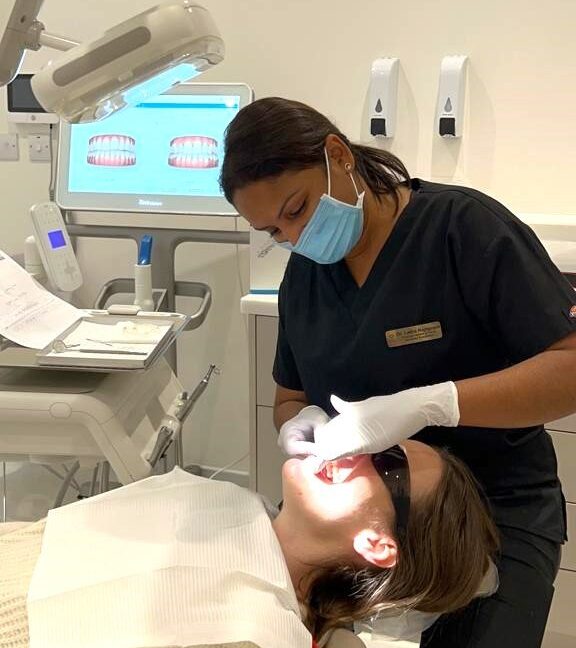April is Oral Cancer Awareness Month. This campaign aims to raise awareness of oral cancer to bring attention to the warning signs, prevention, and treatment of this illness . Oral cancer affects areas in and on the mouth. It can develop on any oral tissue, including your gums, tongue, or lips. Just like any cancer, early detection and prompt treatment can significantly improve outcomes.
In this article we hope to educate others on the following information about oral cancer:
Early signs to be aware of
Who’s at a higher risk of developing oral cancer
Ways can oral cancer be prevented
Keep reading below to further educate yourself on oral cancer. Knowing how to detect and prevent this disease can make all the difference in your oral health care. Let’s make the most of Oral Cancer Awareness Month!

What are the early signs of Oral Cancer?
Since Oral Cancer can develop on any oral tissue, signs can appear inside the oral cavity and outside this also includes your lips.
Here are common signs to be aware of:
- A lip or mouth sore that doesn’t heal.
- A white or reddish patch on the inside of your mouth.
- Loose teeth.
- A growth or lump inside your mouth.
- Mouth pain.
- Ear pain.
- Difficult or painful swallowing.
If you have been experiencing persistent signs and symptoms for two weeks, seeking a medical professional either a dentist or a doctor is strongly suggested as early detection plays a huge role in the outcome, if diagnosed with Oral Cancer. Oral cancer can even be detected during your regular dental check-up, so it is very important to be up to date with your routine dental check-ups.
Have you self-examined lately? This is a great way to keep on top of your mouth and neck health at home. The Mouth Cancer Foundation has a great tutorial with pictures on how to. We have broken it down step by step here:
1.Firstly, you will need a mirror, clean hands, and a good light source. Start by inspecting your face look out for any swelling, is your skin looking different? Have moles become larger or have started itching? Turn your head from side to side as this will stretch your skin making lumps easier to see.
2.Then move down to your neck, using the balls of your fingers feel under your jaw and feel along the large muscle on either side of your neck, look out for swelling and that everything feels the same on both sides.
3.On to your lips, using your index finger, middle finger and thumb feel inside of your mouth. Pull your upper lip and bottom lip downwards and look out for any sores or discoloration. Then feel around the inside of your lips using your thumb and forefinger to check for lumps, bumps, or changes in texture.
4.Moving on to your gums, use your thumb and forefinger on the inside and outside of the gum working your way around the gum to feel for anything unusual.
- 5. Now move on to your cheeks, open your mouth and pull your cheeks away one side at a time. Look out for any red or white patches. Run your finger through and feel for ulcers, lumps, or tenderness.
- 6. Pull out your tongue and look for any swelling, ulcers, or discolouration on each side of your tongue. Inspect the underside of your tongue by touching your tongue to the roof of your mouth.
- 7. Lastly inspect both the roof and floor of your mouth look out for any discolouration. The take your finger and feel around for lumps, swelling or ulcers.
Who is at higher risk of oral cancer?
lifestyle choices can put others at a higher risk of developing oral cancer in their lifetime. Here are some risk factors that can significantly increase the chances of developing oral cancer:
- Tobacco use of any kind, including cigarettes, cigars, pipes, chewing tobacco and snuff, among others
- Heavy alcohol use
- Excessive sun exposure to your lips
- HPV
- A weakened immune system
With this being said, we hope to promote healthier life choices to help decrease the development of oral cancer.
How can oral cancer be prevented?
Unfortunately, there is no proven way to prevent oral cancer. However, you can reduce the risk factors listed above. Here are some ways to reduce your risk when it comes to oral cancer.
- Stop using tobacco. Tobacco, exposes your mouth’s cells to harmful cancer-causing substances.
- Consume alcohol in moderation. Excessive alcohol use might irritate your mouth’s cells, putting them vulnerable to mouth cancer. For healthy individuals, it means no more than one drink per day for women of all ages and men over 65, and no more than two drinks per day for males 65 and younger.
- Avoid excessive sun exposure to your lips. Stay in the shade to protect the skin of your lips from the sun.
- Maintain good oral hygiene. Make it a point to brush and floss your teeth regularly. An unhealthy mouth is a breeding ground for germs and infections HPV is one of leading causes for occurrence of oral cancers. An unclean oral cavity also severely affects your immune system, and inhibits your body’s ability to fight off potential cancers.
- See your dentist on a regular basis. Request that your dentist examine your entire mouth as part of a standard dental exam for atypical spots that could suggest oral cancer or precancerous alterations.
There’s no official screening test for oral cancer. However, your dentist typically looks and feels around for signs of oral cancer during a routine dental check-up. It is important to keep your check-ups.
We hope this article left you feeling more in control of your oral health!
For more information, please contact our friendly reception team who will be happy to share more information about this with https://renu-dental-medispa.dentr.net/ .

